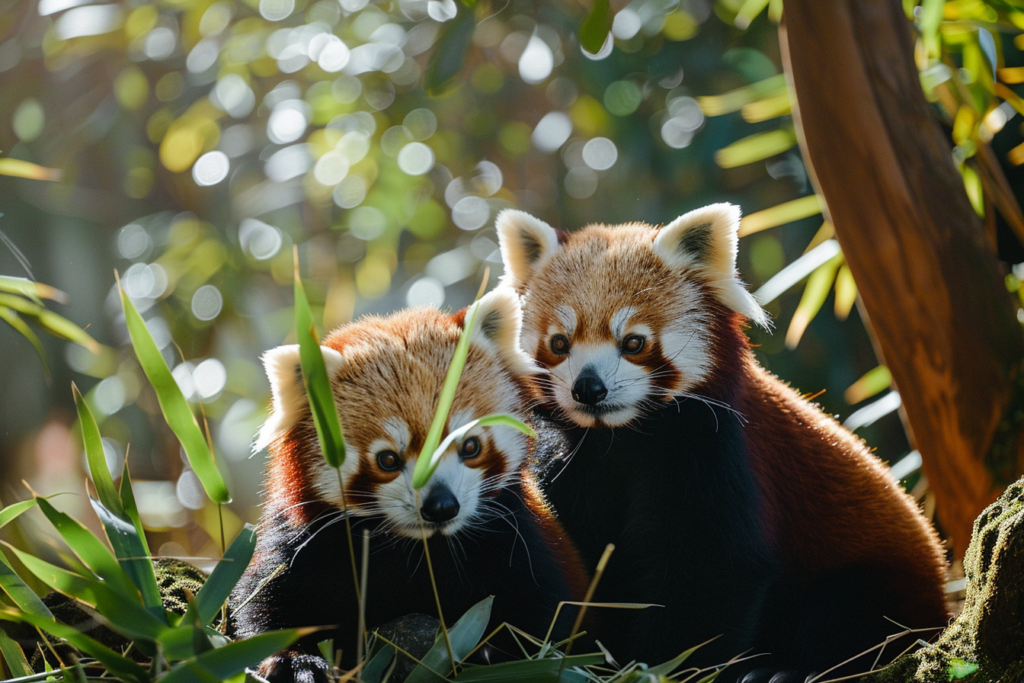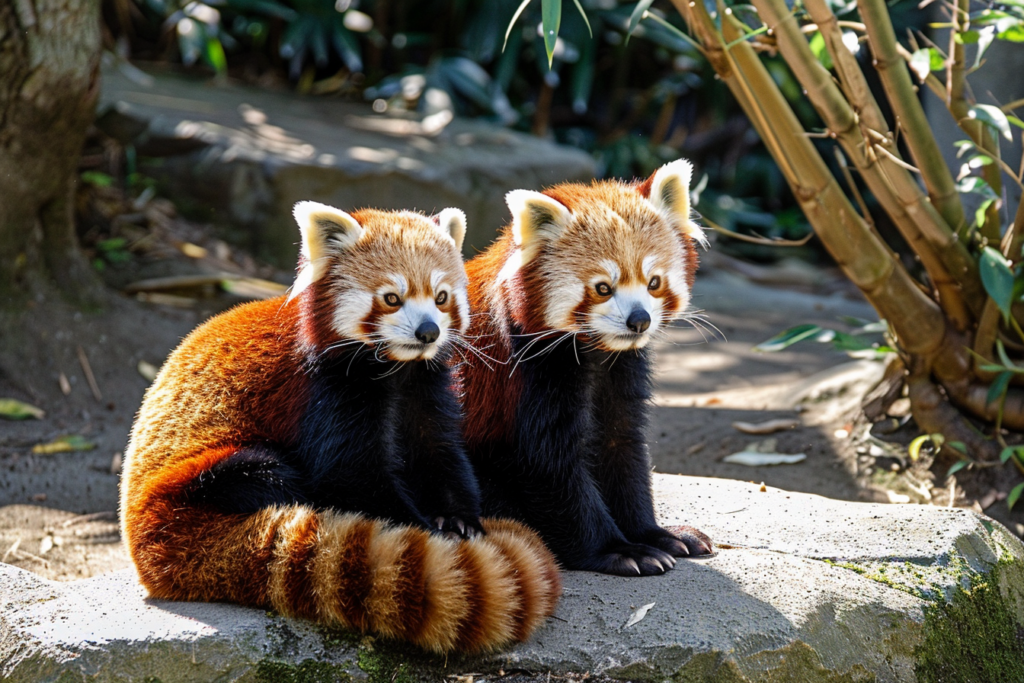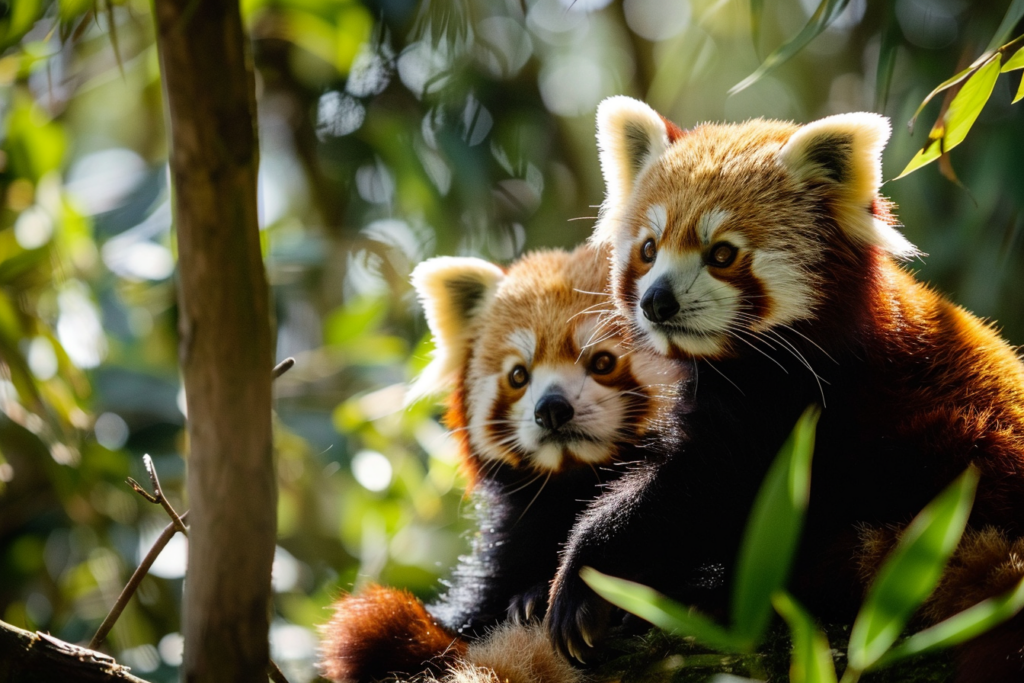Red pandas, native to the eastern Himalayas and southwestern China, are adept climbers with sharp claws and flexible ankles, spending most of their time in trees.
They use their long, bushy tails as built-in blankets to stay warm in cold, mountainous habitats. The tail fur provides insulation, wrapping around their bodies to trap warmth and protect against the chill.
Red pandas thrive in dense forest canopies and primarily eat bamboo, though they also consume eggs, insects, and small mammals.
These solitary, nocturnal creatures face threats from habitat loss and poaching. Learn more about their fascinating lifestyle and conservation efforts.
What Are Red Pandas?
Red pandas are small, tree-dwelling mammals native to the eastern Himalayas and southwestern China. Unlike their distant relatives, the Giant pandas, red pandas boast striking reddish-brown fur and black bellies that make them stand out in their natural habitat. These fascinating creatures are often referred to as the Chinese red panda due to their primary location.
A significant part of their charm lies in how they live and navigate the treetops. Red pandas use their tails for balance while moving along tree branches, making them adept climbers. Their tails also serve as built-in blankets, providing warmth during chilly weather. These physical adaptations are essential for their survival in the forest canopy.

Their diet is primarily composed of bamboo, with about 98% of their intake consisting of bamboo leaves. This bamboo diet necessitates efficient foraging, and their sharp, semi-retractable claws allow them to grasp and strip bamboo stalks effectively. Their reliance on bamboo is similar to that of Giant pandas, highlighting an interesting dietary convergence despite their differences.
Natural Habitat
Nestled in the mountain forests of Nepal, India, Bhutan, Myanmar, and China, red pandas thrive in cold, snowy climates. Their natural habitat comprises temperate forests at high elevations, typically ranging from 2,200 to 4,800 meters. These forests provide an ideal environment for red pandas, as they’re rich in bamboo, which forms a significant part of their diet.
While we’ll discuss their dietary habits later, it’s important to note that the presence of bamboo plays a vital role in sustaining these adorable climbers.

Red pandas prefer forest habitats that offer dense canopy cover and numerous trees, where they can rest and find shelter. These forest homes are essential for their survival, providing not only food but also protection from predators. The mountain forests’ diverse ecosystem supports a variety of flora and fauna, contributing to the overall ecological balance.
In these high-elevation temperate forests, red pandas are mostly solitary and are active during the dawn and dusk hours. Their arboreal lifestyle allows them to navigate the forest canopy with ease, using their sharp claws and agile bodies. This unique adaptation helps them maintain their forest homes and control bamboo growth, ensuring the health of their natural habitat.
Dietary Habits
When it comes to dietary habits, red pandas primarily consume bamboo, making up about 98% of their diet. They munch through approximately 20,000 bamboo leaves daily. Despite bamboo being the cornerstone of their diet, red pandas have a unique way of approaching their meals. They prefer young, tender bamboo leaves over the older, tougher ones. This preference is essential, as their digestive system can only process about 24% of the bamboo they ingest.
Red pandas also occasionally diversify their diet with eggs, insects, and small mammals. These supplementary food sources are important, especially when bamboo is scarce.
The red panda’s low metabolic rate reflects its diet; bamboo isn’t particularly high in nutrients, necessitating a slow energy burn. This adaptation allows them to conserve energy while making the most of their limited nutritional intake.
Their digestive system is specially adapted to handle a bamboo-heavy diet, yet it’s not as efficient as that of giant pandas, who share a similar diet. Despite these limitations, bamboo remains a critical component, providing essential nutrients and support for their health and survival.
Understanding their dietary habits provides insight into their daily life and ecological needs.
Red Panda Climbing Abilities
With their sharp claws and flexible ankles, red pandas are exceptionally skilled climbers, effortlessly traversing the treetops. Their impressive climbing abilities are essential to their arboreal lifestyle, allowing them to navigate the forest canopy with ease. Red pandas spend most of their time in trees, where their agility and balance are vital for accessing food sources and avoiding predators.

A red panda’s tail plays a significant role in their climbing prowess. Acting as a counterbalance, their tails enable them to maintain stability and coordination while moving between branches. This balance is imperative for their survival in the dense forest habitat they call home. The tails also enhance their agility, helping them make quick, precise movements necessary for efficient tree traversal.
In their forest habitat, red pandas utilize their climbing skills to forage for food, primarily bamboo, and to find safe resting spots high above the ground. Their sharp claws grip the bark securely, and their flexible ankles allow them to descend headfirst, a rare ability among mammals.
These physical adaptations make red pandas adept at living an arboreal lifestyle, showcasing their unique climbing abilities in the treetops.
How Do Red Pandas Use Their Tail as a Blanket?
Red pandas cleverly use their long, bushy tails as built-in blankets to stay warm in cold and snowy climates. The thick fur on the underside of their tails provides essential insulation and protection against harsh weather. When temperatures drop, you’ll often see a red panda wrapping its tail around itself like a makeshift pillow, showcasing its resourcefulness and practical adaptation. This unique behavior aids in thermal regulation, allowing the red panda to conserve energy while resting.

In their natural habitat, red pandas face cold, mountainous environments where maintaining body heat is essential for survival. Their bushy tails play a critical role in this. The tail’s dense fur acts as an insulating layer, trapping warmth and shielding the red panda from the chill. This insulation is especially important during sleep, when the body is more vulnerable to temperature fluctuations.
Social Behavior
Despite being mostly solitary, red pandas engage in fascinating social behaviors that reveal their complex communication skills. They mark their territory using scent glands located on the bottom of their feet and around their anus. This marking helps them establish boundaries and avoid conflicts with other red pandas.
By communicating through body language, they can express various emotions and intentions, such as aggression, submission, or curiosity. Red pandas also use vocalizations to interact with each other. They produce a range of sounds, including tweets, whistles, and squeals, each serving a specific purpose in their social interactions.
These unique social behaviors are essential for their survival and maintaining forest diversity. Moreover, red pandas play a pivotal role in the ecosystem by controlling bamboo growth. Their feeding habits ensure that bamboo doesn’t overgrow, which is vital for the balance and diversity of the forest.
Environmental Threats They Face
Facing numerous threats, red pandas are increasingly vulnerable to extinction. One of the most significant challenges they face is habitat loss due to deforestation and human development. As forests are cleared for agriculture and urban expansion, red pandas lose their homes and food sources. This deforestation not only fragments their habitat but also isolates populations, making it harder for them to find mates and reproduce.

Poaching and the illegal pet trade also pose severe risks. Red pandas are often hunted for their fur, which is used in traditional clothing and accessories. Moreover, they’re captured and sold as exotic pets, despite being unsuitable for domestic life.
Climate change exacerbates these problems by altering their habitat and the availability of bamboo, their primary food source. Rising temperatures and changing precipitation patterns can lead to bamboo die-offs, further endangering red panda populations.
Diseases transmitted from domestic animals, like dogs, can also have devastating effects on wild red pandas. These multiple threats highlight the urgent need for strong conservation efforts. Protecting red pandas from these dangers is crucial to ensure their survival and the preservation of their natural habitat.
Conservation Efforts
Conservationists are working tirelessly to safeguard red pandas from extinction. These adorable climbers are classified as endangered, with fewer than 10,000 adults left in the wild. Conservation efforts focus primarily on combating habitat loss, poaching, and climate change, which are the major threats to their survival. Habitat loss occurs as forests are cleared for agriculture and development, reducing the red pandas’ natural living space.
To address poaching, global initiatives under the Convention on International Trade in Endangered Species (CITES) regulate trade to safeguard red pandas. These regulations aim to prevent illegal hunting and trading of red panda fur and body parts.
Moreover, zoos worldwide participate in breeding programs designed to increase the population of red pandas and ensure genetic diversity. Climate change also poses a significant threat by altering the red pandas’ habitat, making it less suitable for their survival.
Conservationists work on creating and maintaining protected areas where red pandas can thrive. Children can actively participate by raising awareness about red panda conservation and becoming protectors of these unique creatures.
Through these combined efforts, there’s hope for the future of red pandas, guaranteeing they remain an integral part of our planet’s biodiversity.









